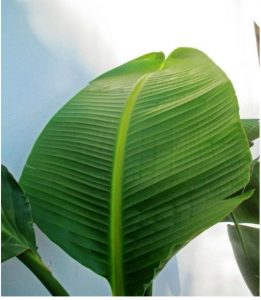By Tommy Clarkson from the August 2014 Edition

Strelitzia Nicolai
Family: Strelitziaceae
Also known as: Giant Bird of Paradise, Wild Banana or Natal Wild Banana
Many of us are confused by the differences and similarities of the Bird of Paradise, White Bird of Paradise and the Travelers Palm.
In the genus of which the first two are a part, there are actually only four species. All are native to South Africa with just two that most of us know.
All have elongated, stalked, paddle-shaped leaves, opposing each other on the same plane, that look similar to banana leaves but are more leathery, stiff and erect. Additionally, their similar in appearance, exotic crane headed looking flowers rise from the leaf axils and are cradled in “large stiff boat like horizontally held bracts or spathes.” (Thank you Robert Lee Riffle for that apt description!) Each of the six or more flowers on any bract consists of three sepals and three petals.
(Time out for a botany words refresher: Axils are the angle between the upper side of a leaf or stem and its supporting stem or branch. A bract is a modified leaf like structure often positioned beneath a flower. A spathe is a large often brightly colored bract that forms a sheath to enclose the flower cluster. A sepal is one of the outermost series of flower parts, arranged in a ring outside the petals. And as bonus information, collectively, the sepals make up the calyx. OK, Time in.)
The two species of the Strelitzia are nicolai (named after Grand duke Nikolai Nikolijevich , who was the third son of Tsar Nicholas I of Russia) and reginae (named after the United Kingdom’s, German born, Queen Charlotte, wife of George III.
Both the white flowered Strelitzia nicolai and the multi-colored Strelitzia reginae grow at a moderate slow rate, increasing in size 20-50% their first year planted. The former can reach a height of around thirty feet (9 meters) with individual leaves of four to six feet long (1.2 – 1.8 meters). The latter which is trunkless seldom gets more than five feet (1.5 meters) tall with each leaf periole (the stalk attaching the leaf blade to the stem) being around three feet (.9 meter) with the leaf blade between a foot (.3 meter) and eighteen inches (.45 meter). Whereas the Travelers Palm (Ravenala madagascariensis) grows at a faster rate, generally, increasing its size at least 50% the first year and growing to as tall as forty feet (12 meters), a plant width of 15′-30′ (4.6 – 9 meters) and with long stalked leaves of ten to twelve feet (3 – 3.6 meters). It’s smaller, white flowers are not as jaw dropping as the other two.
Now, let’s focus on our featured plant.
Strelitzia nicolai – known to some as the Giant Bird of Paradise can grow taller in ideal natural habitat. In containers, it may reach heights of fifteen feet (4.5 meters) or less. Toward the lower front of the large, bird-like, 12-inch (.3 meter) white, cream or pale grey flowers is a striking blue tongue. The flowers bloom periodically throughout the year but more so in the winter.
Growing environs and conditions are similar for both S. nicolai and S. reginae. Partial shade to full sun is ideal with wind protection that will keep the large, banana-like leaves from being torn. They prefer rich loamy soil and regular watering. When “containerized” indoors, the evening temperatures should remain above 50 to 55 degrees Fahrenheit for optimal growth.
The fastest and easiest way to propagate them is by division of root clumps. Seed propagation is less reliable taking up to 18 months to germinate. (It’s wise, anyway, to regularly thin these clumps.)
The White Bird of Paradise is a “close up and personal” plant. It is a wonderful choice silhouetted against a wall and, in that it is moderately salt tolerant, is ideal for coastal planting. Beyond that let’s say you enjoy skinny dipping in your pool it’s an ideal screening plant.
Similar to the Travelers Palm, the symmetry of it overlapping at the base, horizontal plane leaves are truly a beautiful sight.
Of what other uses might there be for this plant? Well, the seed capsules can be ground into flour, mixed with water and made into a fritter into which the arils (the fleshy seed covering) can be inserted and then baked over coals. Also, the leaves are used in some locales for lining damp corn pits. Lastly, (I don’t make this stuff up) according to Palmer and Pitman (1972): “Zulus use the spathes as penis boxes”. . . . and all this time I’ve gone to WalMart!
For back issues of “Roots”, gardening tips, tropical plant book reviews and videos of numerous, highly unique eco/adventure/nature tours, as well as memorable “Ultimate Experiences” such a Tropical Garden Brunches and Spa Services, visit us at.. www.olabrisagardens.com


Download the full edition or view it online
—
Tommy Clarkson is a bit of a renaissance man. He’s lived and worked in locales as disparate as the 1.2 square mile island of Kwajalein to war-torn Iraq, from aboard he and Patty’s boat berthed out of Sea Bright, NJ to Thailand, Germany, Hawaii and Viet Nam; He’s taught classes and courses on creative writing and mass communications from the elementary grades to graduate level; He’s spoken to a wide array of meetings, conferences and assemblages on topics as varied as Buddhism, strategic marketing and tropical plants; In the latter category he and Patty’s recently book, “The Civilized Jungle” – written for the lay gardener – has been heralded as “the best tropical plant book in the last ten years”; And, according to Trip Advisor, their spectacular tropical creation – Ola Brisa Gardens – is the “Number One Tour destination in Manzanillo”.





You must be logged in to post a comment.